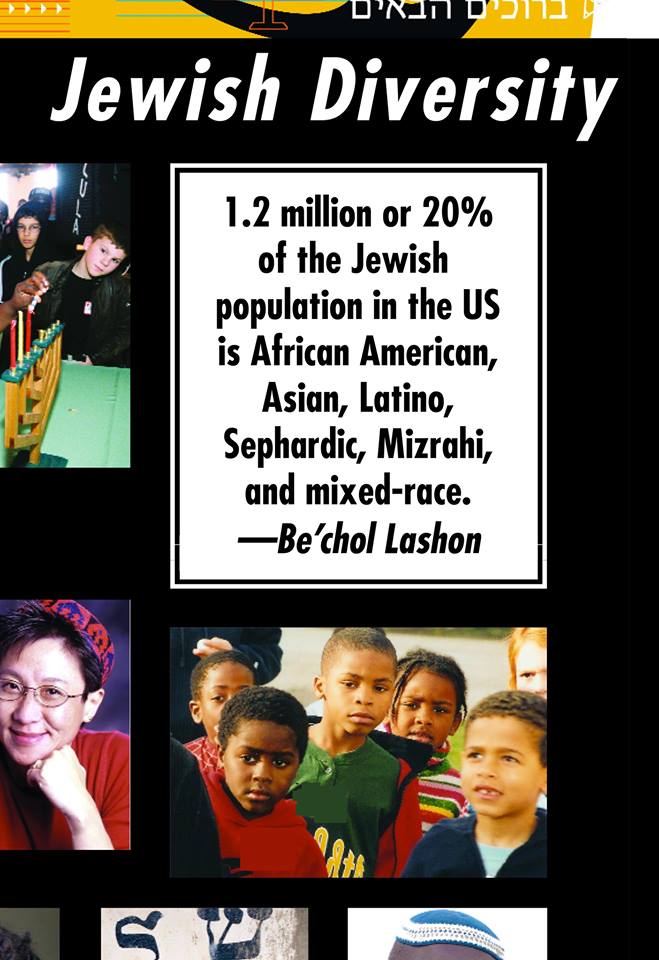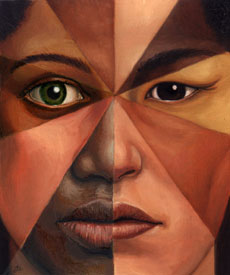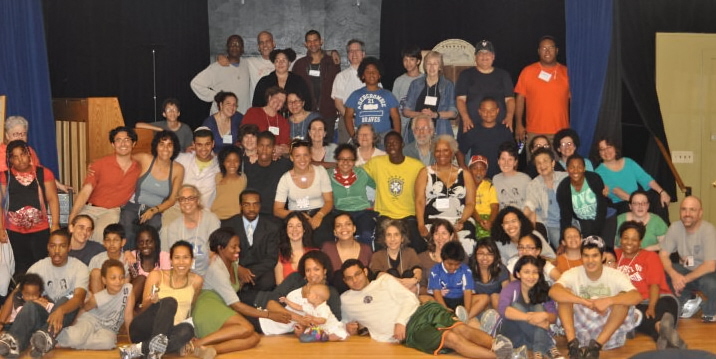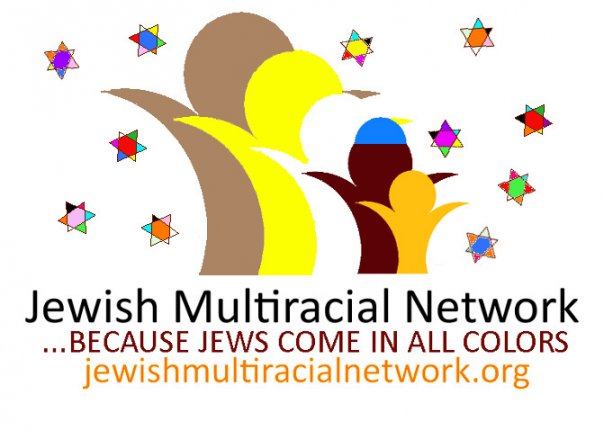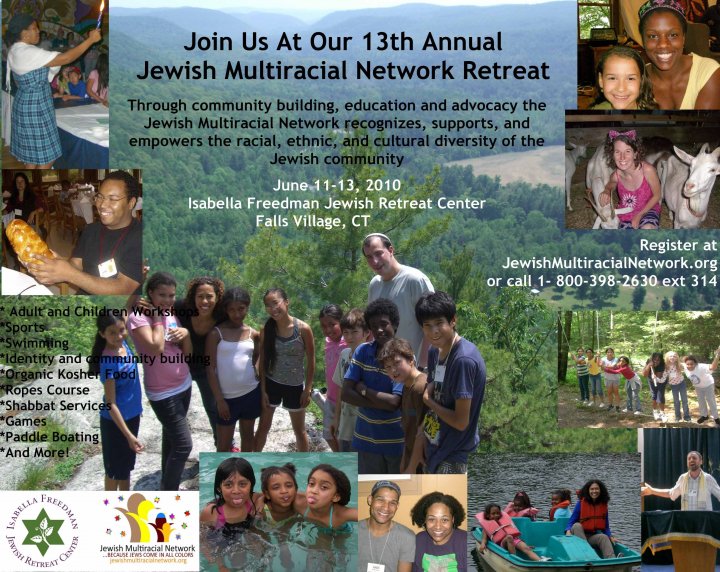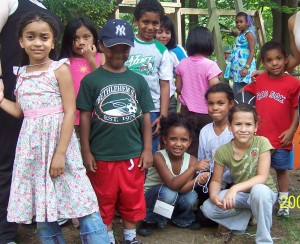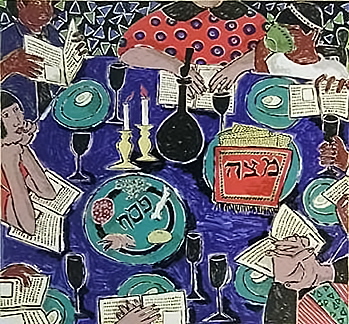Posts Tagged ‘jews of color’
Jews of Color is a pan-ethnic term that is used to identify Jews whose family origins are originally in African, Asian or Latin-American countries. Jews of Color may identify as Black, Latino/a, Asian-American or of mixed heritage such as biracial or multi-racial.
Due to several factors, Mizrachi and Sephardi Jews from North African and Arab lands vary in whether or not they self-identify as “Jews of Color.”
“The Jewish experience is built upon foundations of diversity as old as the Jewish people, a reality that may be lost to many Jews who tend to think of other Jews as being only like themselves. The historical home of the Jews lies at the geographic crossroads of Africa, Asia, and Europe. Jews are an amalgam of many peoples and Jewish origins include a multitude of languages, nations, tribes, and skin colors.” ~The History of Jewish Diversity/ Be’chol Lashon
The first show of its kind, Jews of Color explores the cultural and ethnic diversity of the Jewish community, sharing the unique perspectives of Jews from African-American, Asian, Hispanic and other non-”white” backgrounds. Defying our collective assumptions about what it means to be a Jew, and shedding light on perspectives that are too often ignored by the broader Jewish community, Jews of Color is not to be missed.
Featuring: host Joel Sanchez (Jewish Board of Family and Children’s Services), Aliza Hausman (Blogger, “Memoirs of a Jewminicana”), Akira Ohiso (Author, “Survivor”), Yitz Jordan a.k.a. Y-Love (Rapper, Writer, Activist), and Yavilah McCoy (Jewish educator, Diversity Practitioner, and Founder of Ayecha Jewish Diversity Resources).
“The most powerful thing I want to happen in the Jewish community is that we gain more space of love for one another…”~Yavilah McCoy
Who Counts? Race and the Jewish Future
Racism in the Jewish Community: The Uncomfortable Truth via ELItalks
Jews of color account for about one-fifth of the world’s Jews. Still, to many people, Jewish means white.
Today, a new generation of diverse Jews is coming together to correct that misperception. Individuals from a variety of racial and ethnic backgrounds – some who were born Jewish, others who converted – are using websites, community groups and festivals to meet up and band together.
Our goal is to remind the world that Jews Come in All Colors – and that, is something to celebrate!
The Jewish Multiracial Network…Because Jews Come in All Colors Poster

POSTER TEXT BOXES:
DID YOU KNOW?
The Jews of China built their famous “Purity and Truth” synagogue in the third year of the Da Ding period (1163) of the Jin (Golden Tartar) Dynasty, in the ancient Chinese capitol city of Kaifeng.
DID YOU KNOW?
15,000 Black African Jews, who trace their 3,000 year history to the time of Israel’s King Solomon, were flown from Ethiopia to Israel in 36 hours in May 1991.
DID YOU KNOW?
Spanish & Portuguese “Crypto” (secret) Jews arrived in New Mexico some 500 years ago, fleeing the Spanish Inquisition. Their descendants still recite Shabbat blessings in Ladino (archaic Spanish).
DID YOU KNOW?
In India, the Bene Israel community—their ancestors arrived there 2,000 years ago—are called “Shanwar Telis” (Saturday Oil Pressers) as they refrain from work on the Shabbat.
DID YOU KNOW?
The Jews of Morocco make pilgrimage each year to the tombs of 13 Holy Sages, and celebrate a unique Jewish holiday called Mimunah.
This year’s annual Jewish Multiracial Network (JMN) retreat at the Isabella Freedman Jewish Retreat Center in Falls Village, CT. was fantastic!! There was a palpable joy in the air. New participants and habitual attendees combined to make the Jewish Multiracial Network’s Bar Mitzvah year one to remember. See Photos!
Remember: “You are not alone. Just pull up a mental vision of a Jews of Color (JOC) version of the Verizon [network] commercial where all those people are standing behind the technician – You in front and all of the rest of us standing behind you ready to assist – the days of any of us fighting alone are over – keep the image present in your mind as you encounter people’s ignorance…” ~Yavilah McCoy
The Mission of the Jewish Multiracial Network (JMN) is to build a community of Jews of color and multiracial Jewish families for mutual support, learning, and empowerment. Through education and advocacy, JMN seeks to enrich Jewish communal life by incorporating our diverse racial and ethnic heritages.
The Jewish Multiracial Network brings Jewish multiracial families and individuals together to learn about and celebrate their Judaism. JMN is committed to diversity and inclusive community-building, and seeks to help it’s members strengthen their identities as Jews and members of other ethnic groups. JMN creates opportunities for learning, nurturing and support for a large and growing part of the Jewish community that often feels marginalized by mainstream Jewish organizations. You are invited to become a part of this developing national Jewish multiracial network. Click HERE!
The Jewish Multiracial Network…Because Jews Come in All Colors Poster

POSTER TEXT BOXES:
DID YOU KNOW?
The Jews of China built their famous “Purity and Truth” synagogue in the third year of the Da Ding period (1163) of the Jin (Golden Tartar) Dynasty, in the ancient Chinese capitol city of Kaifeng.
DID YOU KNOW?
15,000 Black African Jews, who trace their 3,000 year history to the time of Israel’s King Solomon, were flown from Ethiopia to Israel in 36 hours in May 1991.
DID YOU KNOW?
Spanish & Portuguese “Crypto” (secret) Jews arrived in New Mexico some 500 years ago, fleeing the Spanish Inquisition. Their descendants still recite Shabbat blessings in Ladino (archaic Spanish).
DID YOU KNOW?
In India, the Bene Israel community—their ancestors arrived there 2,000 years ago—are called “Shanwar Telis” (Saturday Oil Pressers) as they refrain from work on the Shabbat.
DID YOU KNOW?
The Jews of Morocco make pilgrimage each year to the tombs of 13 Holy Sages, and celebrate a unique Jewish holiday called Mimunah.
Jews of Color Roundtable Airing On The Jewish Channel
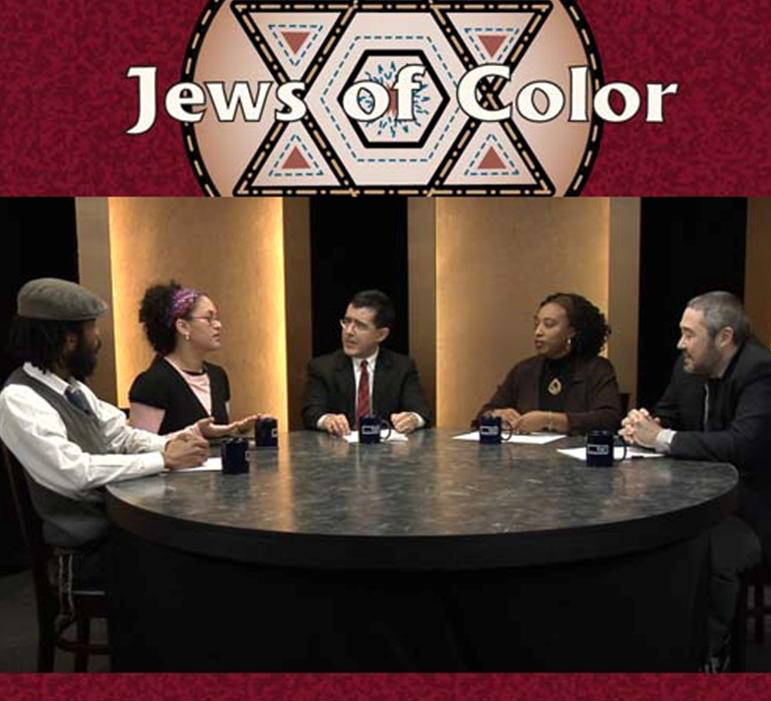
The first show of its kind, Jews of Color explores the cultural and ethnic diversity of the Jewish community, sharing the unique perspectives of Jews from African-American, Asian, Hispanic and other non-”white” backgrounds. Defying our collective assumptions about what it means to be a Jew, and shedding light on perspectives that are too often ignored by the broader Jewish community, Jews of Color is not to be missed.
Featuring: host Joel Sanchez (Jewish Board of Family and Children’s Services), Aliza Hausman (Blogger, “Memoirs of a Jewminicana”), Akira Ohiso (Author, “Survivor”), Yitz Jordan a.k.a. Y-Love (Rapper, Writer, Activist), and Yavilah McCoy (founder Ayecha).
Originally posted here: Zinc Plate Press Blog
Jewish Multiracial Network Thirteenth Annual Retreat: June 11 – 13, 2010
Join dozens of other Jewish multiracial families and Jews of Color of all ages for an inclusive Shabbat experience that will celebrate the diversity of our community. The weekend includes exciting adult discussions and workshops, youth and teen programming, childcare, multi-generational family programming and time to relax and enjoy all that the Isabella Freedman Jewish Retreat Center and JMN have to offer.
Ashkenazi and/or White Jewish Privilege Checklist
I can walk into my temple and feel that others do not see me as outsider.
I can walk into my temple and feel that others do not see me as exotic.
I can walk into my temple and feel that my children are seen as Jewish.
I can walk into my temple with my family and not worry that they will be treated unkindly because of the color of their skin.
I can enjoy music at my temple that reflects the tunes, prayers, and cultural roots of my specific Jewish heritage.
No one at my synagogue will attempt to assign me to a ethnicity to which I do not belong (e.g., assuming all Jews of African descent are Igbo or Ethiopian).
I can easily find greeting cards and books with images of Jews who look like me.
I can easily find Jewish books and toys for my children with images of Jews that look like them.
I am not singled out to speak about and as a representative of an “exotic” Jewish subgroup.
When I go to Jewish bookstores or restaurants, I am not seen as an outsider.
I find my experiences and images like mine in Jewish newspapers and magazines.
I do not worry about access to housing or apartments in predominately Jewish neighborhoods.
My rabbi never questions that I am Jewish.
When I tell other members of my synagogue that I feel marginalized, they are immediately and appropriately responsive.
There are other children at the religious school who look like my child.
My child’s authenticity as a Jew is never questioned by adults or children based on his/her skin color.
People never look at me and say “But you don’t look Jewish” either seriously or as though it was funny.
I do not worry about being seen or treated as a member of the janitorial or administrative staff at a synagogue or when attending a Jewish event.
I am never asked “how” I am Jewish at Jewish dating events or on Jewish dating websites.
I can arrange to be in the company of Jews of my heritage most of the time.
When attempting to join a synagogue or Jewish organization, I am sure that my ethnic background will not be held against me.
I can ask synagogues and Jewish organizations to include images and cultural traditions from my background without being seen as a nuisance.
I can enroll in a Jewish day school, Yeshiva, and/or historically Jewish college and find Jewish students and professors with my racial or ethnic background.
People of color do not question why I am Jewish.
I know my racial or ethnic background will not be held against me if I attempt to join a minyan in prayer.
I know my ethnic background will not be held against me in being called to read the Torah.
I am not discriminated against in the aliyah process as a Jew of my particular ethnicity.
Text not copyrighted. Developed for educational purposes by the Jewish Multiracial Network, 2006–2009. Please distribute and add to the checklist.

“Jewish life will be fine with all sorts of communities and groupings with all sorts of people -Jews and non-Jews- being Jewish, using Jewish wisdom and practice, in many ways that we can not even imagine.” ~ Irwin Kula, Renowned Thinker, Teacher, Author & Rabbi
In Loving Color
By Rachel Sarah
Raising a biracial Jewish daughter, a mother finds herself answering many questions: from her child, from total strangers, and from her own heart.
“Mommy, you became Jewish when you had me.”
That’s how Mae, my eight-year-old daughter, explains it, and she’s right. Sort of. Mae was seven months old when her father walked out and I became a single mom. At that point in my life, I’d never been so far from Judaism. I was firmly planted in motherhood, but it would take me a while to see that I needed my religious roots to unfold.
Today, Mae is a spirited second grader with a beautiful afro, cinnamon skin, and full lips. Many people assume we’re not related. But Mae — who is quite a sensitive child otherwise—isn’t self-conscious about looking different from her Jewish peers. I, her mother, am the one who sometimes feels — or is made to feel — insecure.
It’s not as if we shouldn’t be used to the idea of mixed-race heritage. There are Jews everywhere — Ethiopia, Russia, China, India. Everyone who visits Israel tells a story of meeting someone who, because of skin color or another physical characteristic, she simply couldn’t believe is one of us. In the United States, according to one study, one of every five Jews (1.2 million people!) is either black, Asian, Latino, of mixed race, or of Sephardic background.
Not me. I’m white, of mostly Polish descent. My father is Jewish; my mother was born Catholic. She stopped going to church in her 20s and supported the raising of her children as Jewish (although she didn’t convert). I had a bat mitzvah and a confirmation. I went to Jewish summer camps. I went to Israel. I was told that 60 of my relatives were lost in the Holocaust — the single fact that always kept me deeply connected to Judaism. But when, in my 17th year, a rabbi in Israel told me that I wasn’t “really” Jewish because my heritage hadn’t been passed down matrilineally, I was crushed. In anger and disappointment, I distanced myself from anything Jewish for more than a decade.
Twelve years later I had Mae. I was living in New York City, and, despite its large Jewish population, I didn’t know any who were of mixed race. When I moved back to the Bay Area to be near my family, there was a Jewish preschool down the street, but I was adamant about not sending Mae there: If I’d felt shunned for not having a Jewish mother, imagine how she would feel. So, I found a diverse, high-energy preschool; she cried for a week. Every afternoon when I picked her up, her eyes were bloodshot.
Friends raved about the nearby Jewish pre-school, so I called: A spot had just opened up. I was unsure, but the moment Mae walked into Kitah Aleph, she felt at home. And she was not alone. Three children were Jewish Asian, one boy was African-American, and a Spanish-speaking girl — her mother, from Venezuela, had worked at the JCC for more than a decade — is still one of Mae’s best friends.
Mae never wanted to go home when school let out. She learned how to count in Hebrew and how to braid (practicing on challah). She expanded my repertoire of Jewish songs tenfold.
But it wasn’t perfect. I once took 5-year-old Mae to a local kids’ Shabbat service at a Conservative shul. We walked in, and everyone stared. After the service, only one person came up and said, “Hi.” She was the white mom of an adopted son with brown skin. While researching this article, I called that mom —who asked to remain anonymous — and asked whether anyone at her temple mentioned her son’s race. “They ignore it,” she said. “No one talks about it.”
Nevertheless, her son recently said to her, “Mommy, most Jews are white.”
Lisa Williamson Rosenberg, a New Jersey psychotherapist and writer, is both Jewish and biracial (her mother is white and Jewish; her father was black). Fortunately, she reports, “the definition of what a Jew looks like has broadened significantly since I was a kid.” She remembers being told, “How can you be Jewish? You’re black.” “As if the two were mutually exclusive,” adds the mother of two (her husband is white and Jewish).
“Today when I say, ‘I’m Jewish,’ I may get a respectful question or two,” Rosenberg says, “but I won’t get the same kind of disbelief I might have in the ’60s. On our two coasts, if you walk into a synagogue there’s a good chance you will find at least a few brownish faces. I think it’s due to the high numbers of interracial marriages, conversions, and transracial adoptions by Jewish parents.”
Diane Kaufmann Tobin, associate director of the Institute for Jewish and Community Research in San Francisco, agrees.
“When I adopted Jonah, I didn’t know any black Jews,” Tobin says about her 10-year-old son, whom she adopted with her husband, Gary, the institute’s president. “I wanted him to grow up Jewish and not have to choose between his racial and religious identities.”
The Tobins, both of whom are white, were determined to find a place where Jonah would feel “very at home being both Jewish and black.” So, they founded San Francisco’s Be’chol Lashon (In Every Tongue) program, which “grows and strengthens the Jewish people through ethnic, cultural, and racial inclusiveness.”
Clearly I’m not the only white mother who hopes her child will feel pride in every facet of her identity. Right now, Mae considers herself Jewish, while others define her — on the basis of what they can see — as black. Looking ahead, I’m not ready for the changes sure to come in her teenage years and beyond, both with how Mae sees herself and how the world does.
I ask Rosenberg for advice on raising my child. “It’s important not to let the black part get lost,” she says.” Being black is something many biracial people take a long time to come to terms with — I did — especially if they identify strongly with whatever makes up the other half. But I believe it’s important to teach a biracial child to love the black in herself, along with everything else.”
One of my closest friends — a white, Jewish mom whose extended family is Orthodox — is doing just that. She had her 7-year-old daughter with an African man who’s no longer in the picture. The Jewish part is easy, says my friend (who requests to keep her family anonymous) about raising her daughter. “She was named in a Jewish ceremony at temple. My grandmother even came out from the Midwest.” And her daughter? “She never questions that she is Jewish.”
Instead, my friend worries about helping her child identify with the rest of her background. During Black History Month, her daughter started asking questions about her African roots. Not sure what to do, my friend enrolled her first-grader in an African drumming class; she didn’t love it, but Mom persuaded her to keep going “because I don’t know how to help her feel the parts of her that are not parts of me.”
“It’s hard, with so many negative images of blacks in the media, especially if the child isn’t living with a black family member,” Rosenberg adds. “It’s a process that I’m still working on. And I’m in my 40s.”
My daughter, too, seems to have no questions about her Jewishness. She is secure and happy at our local JCC. She attends a Jewish after-school program and will soon start her fourth summer at Jewish day camp. When she’s with her Jewish friends, she isn’t shy, the way she often is in public. She volunteers to act in skits; she shows new kids where the bathroom is; she teases her counselors . (She did confess to embarrassment, however, when she was recently proclaimed “Mensch of the Week” in front of the entire after-school group).
I’m the one still feeling like an outsider.
Recently, a Jewish friend invited us to a neighborhood party. As I was pouring myself a glass of wine—and Mae was asking if she could have another cookie — a local dad asked me, “Where did you adopt your daughter?”
Pointing to my belly I answered point-blank, “She came from right here.”
I’ve got that answer down pat because adults and children have asked me many times whether Mae was adopted (along with other common kid questions, like “Why is her hair curly and yours straight?” and “Where’s her daddy?”).
Scott Rubin, a Jewish dad in San Francisco who, with his partner Stephen Moore, has adopted two children, one African-American, the other African-American and Latino, says that strangers also have approached him with questions. First, he tries to gauge their intentions. Then, he wants to know why they’re asking. “I always try to tell the truth,” he says, “but I don’t always elaborate. And if they ask, ‘Are they your kids?’ I say, ‘Yes.’ But I do not engage in conversations about ethnicity or race with strangers. Ever.”
Says Diane Tobin, “What I’ve learned from other Jews of color is they don’t want to be asked, ‘Why are you Jewish?’ or ‘How are you Jewish?’ It’s rude. We need to educate people about what to say or not to say.”
For me, biracial Judaism is a touchy subject. When white Jews ask about my daughter’s identity, I appreciate their curiosity as long as their tone is respectful and warm and as long as their questions are directed to me.
Rosenberg says, “It’s not your daughter’s job to answer. As a parent, you need to step in and say, ‘Why do you ask?'”
Still, if Jews are not acknowledging my daughter’s biracial identity, are they really ignoring her?
“Don’t look at the container, but look at what’s inside.” That’s from Pirkei Avot — Ethics of Our Fathers, Chapter 4, Mishnah 27. I’m led to that tenet by Rabbi Judah Dardik of the Beth Jacob Congregation in Oakland. Although we couldn’t be more mismatched — I’m a 35-year-old single mom who never goes to temple and had a child with a man outside the tribe; he’s Orthodox, married, and the father of four — Dardik is my go-to rabbi because he’s thoughtful, respectful, and patient.
I catch him on the phone on a Friday, an hour before sundown, and apologize for not calling earlier. I tell him that I’m trying to write about what it’s like to raise a biracial Jewish child, but every time I sit down at my computer, what comes out sounds overly defensive.
“Many Ashkenazi Jews tend to assume that Jews are white,” Dardik says, “but it’s not true. Jews come in different shades and colors.” In Judaism, he explains, what matters is not what you look like on the outside — your “container” — but what “merit you have on the inside.”
I’ve done something right, because clearly Mae isn’t afraid to show her “inside.” Maybe it’s time for me to open up a little bit, too.
Seasons in Sheol: A Black Woman’s Nightmare Journey
Through Synagogue Culture
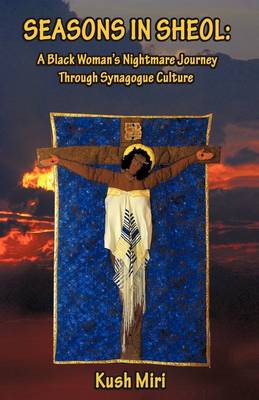
A self-professed and eager integrationist, author Kush Miri converted to Judaism and entered the synagogue’s employ with high hopes and an open heart. Her experiences there left her without faith in God, physically and mentally scarred, and abandoned by her congregation. In this memoir, Miri reveals the discrimination and persecution that took place during her seven years of employment.
Season in Sheol paints a portrait of Miri’s difficult inner-city childhood, her early family and religious experiences, and her journey to enter the Jewish faith. Ten years after converting to Judaism, Miri accepts a job in a synagogue and immerses herself in Jewish culture. Her descriptions of the activities, rites and practices of Judaism, and Judaism’s history provide a fresh and comprehensive overview for both Jews and non-Jews. Initially welcomed among her congregation, Miri experienced a radical change in their attitude. With the arrival of a new rabbi, she found herself castigated by congregants with whom she had formed warm and cordial relations.
Despite her bitter experience, Miri refuses to renounce Judaism—an essential part of her identity. Season in Sheol serves as an important reminder that people can convince themselves of inner good while committing outer acts of malice.
Kushi Miri was a teen actress in musical theatre. As a writer, her journalism has appeared in national magazines, and her poetry has appeared in literary anthologies. She is an accomplished textile artist and her artwork has been on exhibit throughout the Northeast. She is married and has one daughter. I am honored to call her my friend.
The Inside Story on Passover
—————————-
In each one of us there is an Egypt and a Pharaoh and a Moses and Freedom in a Promised Land. And every point in time is an opportunity for another Exodus.
Egypt is a place that chains you to who you are, constraining you from growth and change. And Pharaoh is that voice inside that mocks your gambit to escape, saying, “How could you attempt being today something you were not yesterday? Aren’t you good enough just as you are? Don’t you know who you are?”
Moses is the liberator, the infinite force deep within, an impetuous and all-powerful drive to break out from any bondage, to always transcend, to connect with that which has no bounds.
But Freedom and the Promised Land are not static elements that lie in wait. They are your own achievements which you may create at any moment, in any thing that you do, simply by breaking free from whoever you were the day before.
Last Passover you may not have yet begun to light a candle. Or some other mitzvah still waits for you to fulfill its full potential. This year, defy Pharaoh and light up your world. With unbounded light!
